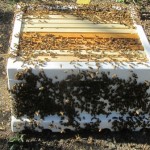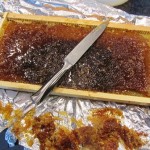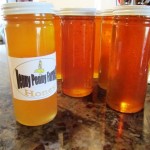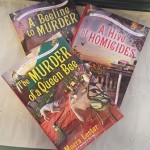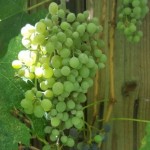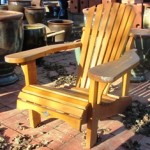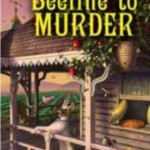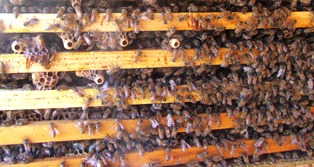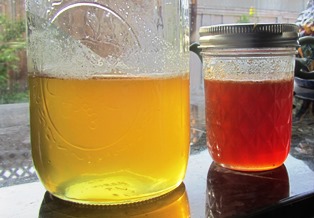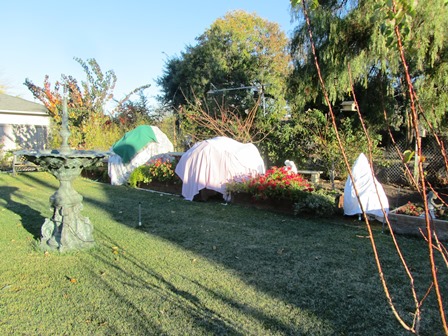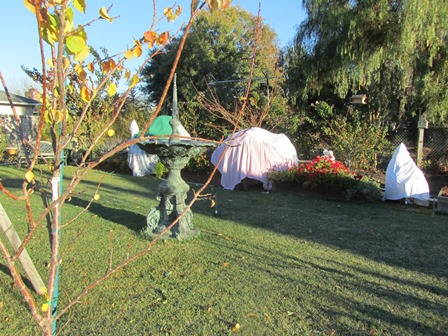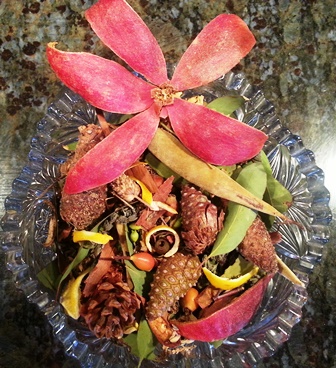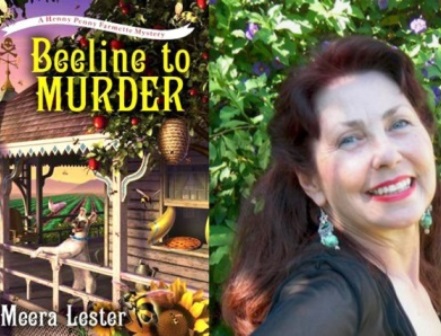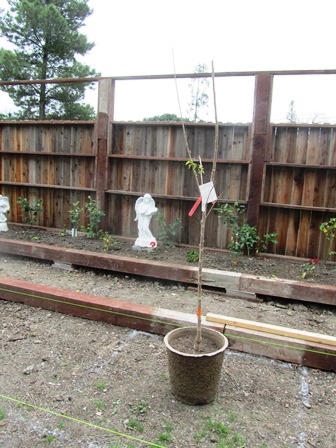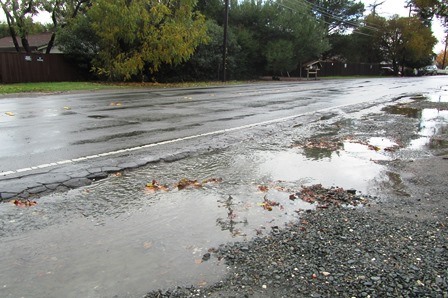Keeping Bees Feeds the Family
The sight of bees collecting pollen makes me happy. Always has. Honeybees are vital to the production of the foods we love such as almonds, apples, citrus, melons, and a large variety of vegetables. My vegetable garden and fruit trees are incredibly productive because of my backyard bees. I guess you could say they feed my family through pollination.
Bees are pollinators. Without them there’s a good chance we’d suffer food scarcity on our planet. Three out of four crops around the globe that are foods that we humans eat are dependent in large part on pollinators. Honeybees also produce honey, nature’s most delicious sweetener, in my opinion.
I keep hives of honeybees on my farmette. It’s not a commercial operation but a backyard hobby that supplies honey for my family and friends as well as pollinating a huge variety of vegetables, fruits, and berries that I grow. Caring for the bees is relatively easy. Harvesting honey, on the other hand, is a bit of work but work I am happy to do.
The first step in harvesting honey is to open the hives. The use of a smoker helps calm the bees. Working quickly is a good idea. We never remove all frames of honey from the hive, but rather leave frames with baby bees and some frames with honey so the bees have food, too.
New frames (some are previously used frames that have the wax structure intact) are inserted to replace the removed frames of honey. A super with 10 frames of honey is carried into my kitchen. Inevitably, I have to capture and release a half dozen live bees that ride in on the frames.
Each frame then gets a hot knife slipped just under the layer of wax. With the wax removed from both sides of the frame, only honey is left. This must be spun out or drained off.
I put four frames of honey at a time into the spinning machine in my kitchen. Beneath the machine’s spigot is freshly washed honey bucket, draped with a new cloth strainer that I’ve taped in place over the top of the bucket. It will catch any pieces of wax or other debris.
When the bucket is full, the strained honey is poured into jars to use, store, or give away as gifts. I put a tight-fitting lid on the bucket and keep the bucket within easy reach on the kitchen countertop.
We eat honey year round. I especially love it in the winter because it reminds me of the honey-flow in spring when the farmette smells like honey and my kitchen is saturated with the scent after pulling some frames from the hive.
Also, the vegetables and fruits that I harvest throughout the growing season are either immediately consumed or preserved through hot-water canning, dehydration, flash freezing. I thank Mother Nature for the blessing of bees that pollinate our foods and give us delicious honey from their hive–up to six gallons for ten frames from a full-depth box!
*NOTE: Learn more about honey bees at: https://www.nationalgeographic.com/animals/invertebrates/h/honeybee/
Also, check out: https://honeybeenet.gsfc.nasa.gov/Honeybees.htm
___________________________________________________________
Enjoy reading about country living? Check out my Henny Penny Farmette series of cozy mysteries that also include lists of farm chores, delicious recipes, farm sayings, and tips for healthy living. Or, take a look at my health, wellness, and spirituality books. All are available online and everywhere books are sold.

More than 150 rituals for sound mind, strong body, and meaningful connections to the people around you
Springtime Projects on the Farmette
After weeks of rain, Mother Nature has put on a robe of splendor. Warm weather has arrived. Already, my beekeeper neighbor has had his honeybee hives send out three swarms.
My own bee population seems to be swelling. I’ve fished out my swarm catcher, primed it with scented lemon oil, and placed in among the blossoms in a nearby apricot tree. I may be blessed with a swarm as well.
There are plenty of other springtime projects to attend to here on my farmette. I’ve got to reassemble my temporary grape arbor. Each year, I think we’ll build a permanent structure, but there never seems to be enough time.
My cell flats have organic plants up now and ready for placing in my garden or raised beds. I’d like to add some more chicken manure to the strawberries since they are rapidly growing and producing small fruit.
Other plants need a spring feeding–the citrus, apples, and apricots, for example. I usually do the feeding before the trees break bud, so I’m a little late.
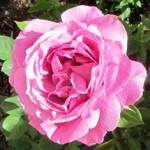
This candy-stripe rose was a gift from a friend–a cutting from her rose that became a large bush in my care
I will be turning the compost pile and mulching all my rose bushes (which have already leafed out and are setting buds). Finally, I’d like to put up a couple more bird houses (mating is already in the air) and fill my hummingbird feeders.
- This–my original flock–was massacred by a wild predator, fox or coyote, last year
I need to purchase baby chicks from the feedstore to start my new flock. Hubby and I will build a new, reinforced chicken run and expand the existing hen house.
Then, there’s the side walkway that needs pavers. Painting of the fences. Building a new porch. Widening the patio…the projects are seemingly endless, but that’s fine. We’ll have a lovely six months (maybe an occasional storm). The dry season is upon us.
And I’m ready for the Adirondack chair…oh, that’s right…we have to build it first!
_________________________________________________________________
If you enjoy reading about farming topics and you love a good cozy mystery, check out my novels from Kensington Publishing–A BEELINE TO MURDER, THE MURDER OF A QUEEN BEE, and A HIVE OF HOMICIDES. All are available on Amazon.com, Barnes & Noble.com, and other online retailers as well as in bookstores everywhere.
Helping the Hummers Refuel
In a single day of darting to and from colorful flowers, the tiny hummingbird consumes nearly half its weight in sugar as it searches for nectar-rich blossoms.

A hummer’s iridescent feathers shimmer as it perches in sunlight at the end of an apricot tree branch
Their wings beat so rapidly, they make a purring sound. Ever industrious, these tiny birds work from dawn to dusk. They are drawn to tubular-shaped flowers or brightly colored ones in shades of red, orange, blue, and pink.
If you want to help the hummers refuel, consider putting flowers on your patio or in your garden that appeal to these little energy burners. Or, better still, plant trees, vines, perennial, and annual plants that will produce the flowers that attract hummers. Choose from the list below.
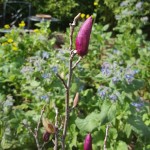
Behind the unfurled buds of the Jane magnolia are the blue blossoms of Borage, an herb frequented by bees, butterflies, and hummers
Annuals: Borage (blue star flower), impatiens, flowering tobacco, petunia, plox, salvia, and snapdragon
Perennials: aloe, alstomeria, bee balm, California fuschia, cardinal flower, columbine, coral bells, foxglove, gladiolus, parrot’s beak, monkey flower, salvia, and sage
Vines: blood red trumpet vine, cape honeysuckle, lonicera (honeysuckle), flame vine, and trumpet creeper
Trees: acacia, chinaberry tree, citrus, coral tree, eucalyptus, silk tree, and tulip tree
______________________________________________________________________
If you enjoy reading about gardening, keeping chickens and bees, and other backyard farming topics, check out my series of cozy mysteries, including A BEELINE TO MURDER, THE MURDER OF A QUEEN BEE, and A HIVE OF HOMICIDES (Kensington Publishing, NY)
A HIVE OF HOMICIDES
Murder of a Queen Bee
A Beeline to Murder
Cold Weather Means Protecting Citrus, Covering Hives
It’s hard to believe Thanksgiving is next week and already, the first snows have arrived in the Sierras and Rockies.

The water in our Italian fountain froze overnight and now the birds and bees that drink there must wait for the sun to melt the ice.
The plunge of nighttime temperatures here on the Henny Penny Farmette are hovering at frost and freezing levels. This morning, I walked with a steaming cup of coffee and noticed the thermometer hovering at 39 degrees Fahrenheit. That means our citrus trees and other frost-intolerant plants must be protected or moved indoors.
The work I’ve been bearing down on–a new book, mystery promo, and prep for Thanksgiving–now have to be put aside for a few hours. I’ve got plenty of cold-weather work to do outside.
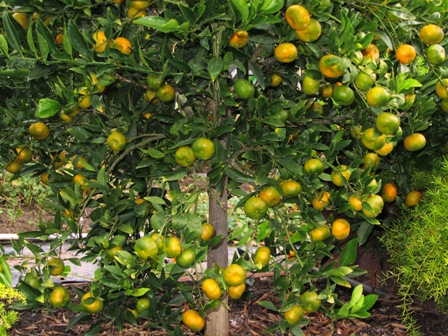
Our Satsuma mandarin orange tree prolifically bears fruit this time of year but is susceptible to freeze
Citrus trees will be covered with blankets against the frost. I’m hanging the heat lamp in my chicken house. I need to clean the chicken house, put more straw in the nesting boxes, and a ground corncob material on the floor. Already, I’ve put the windows back in (leaving a crack open for ventilation).
I opened the beehives last weekend and added an extension onto one hive–something not normally done during autumn when you typically shrink the size of your hives. The hive seemed overpopulated and the bees seemed stressed. After closing that hive, I wrapped both of them with blankets.
With the the citrus protected, the heat lamp in the chicken house, and the beehives covered, I can return to my indoor work . . . it never stops but my passion has always been to live close to the earth and write. This is the good life, made better by this wonderful Mediterranean-like climate that enable our citrus and grapes to thrive (although plunging temps make for a little extra work protecting them).
* * *
Enjoy reading about farming topics? Check out my cozy mysteries–A BEELINE TO MURDER and also THE MURDER OF A QUEEN BEE (both in the Henny Penny Farmette series from Kensington Publishing).
These novels are chocked full of recipes, farming tips, chicken and beekeeping tips, sayings and, of course, a charming cozy mystery. For more info, click on the links under the pictures.
The books are available through online retailers such as Amazon, Barnes & Noble, Kobo Books, and Walmart as well as from traditional bookstores everywhere.
See, http://tinyurl.com/hxy3s8q
This debut novel launched the Henny Penny Farmette series of mysteries and sold out its first press run. It’s now available in mass market paperback and other formats.
See, http://tinyurl.com/h4kou4g
NEWLY RELEASED! This, the second cozy mystery in the Henny Penny Farmette series, is garnering great reviews from readers and industry publications.
Preparing Honeybee Hives for Spring
Recently, I conducted a mid-winter check of my honeybee hives. With my beekeeper neighbor’s help, we opened my Henny Penny Farmette Hives A and B to search for signs of an increase in the mite population, the presence of other pests, and evidence of mold. Inspecting and treating bees with medicines when necessary are important bee management practices.
We found one bug that I couldn’t identify but my neighbor explained it lays a narrow worm and must be removed before its numbers increase. This we did. We also found three frames in Hive B that had a few spots of mold. We threw away the frames and replaced them with wax-covered frames in the lower hive box where the queen had already produced lots of bee babies.
There appeared to be adequate stores of honey, baby bee food, and lots of baby bees. In fact, we removed a few frames of honey from both hives. In their place, we inserted frames that previously had the honey drained off but wax left intact (these I always freeze before putting back into hives since freezing kills mites, larvae, and wax moth), making it easier for the bees to start building comb.
The honey I harvested is dark-colored and earthy tasting, typical of autumn honey when the bees collect pollen from eucalyptus, star thistle, and other sources available in autumn. In contrast, spring honey is light-colored and slightly citrus tasting from pollen gathered from blooming citrus trees and wildflowers.
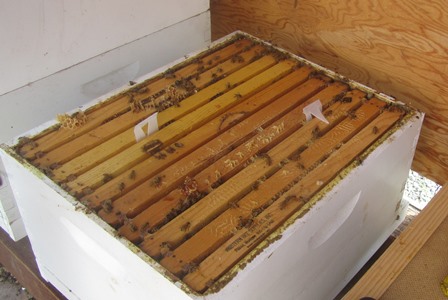
Hang medicated miticide strips between frames inward from the edge of the hive box for mite control.
Since we found evidence of mites, we hung miticide strips between frames to combat tracheal and Varroa mites. Also, we sprinkled powdered sugar medicine (Tetra-Bee Mix 2X Medicated) over the frames to control risk of American foulbrood. Treating the hives thus will enable the bees to remain robust. I expect their numbers to swell with warmer weather which, in turn, translates to new swarms in the spring.
*Apivar is an effective treatment of Varroa mites. One strip per four to five frames works through contact and should be placed in high bee activity areas. Not to be used when honey supers (top hive boxes with frames of honey) are on.
*Tetra-Bee Mix 2 X Medicated is recommended for control of American foulbrood caused by paenibacillus larvae and European foulbrood caused by streptococcus pluton susceptible to oxytetracycline in bees when used as directed.
For more beekeeping tips, delicious recipes, and a wholesome whodunnit, check out my Henny Penny Farmette cozy mysteries: A BEELINE TO MURDER (paperback release in October 2016), MURDER OF A QUEEN BEE (hardcover October 2016), and HIVE OF HOMICIDES (October 2017). Find them on Amazon.com, Barnesandnoble.com and other online and conventional bookstores everywhere.
A Prowling Raccoon Looking for a Warm Chicken Dinner
My farmette looks like some kind of ghostly haunt after sunset. That’s because of all the bed linen I’ve draped over citrus trees and frost-sensitive plants. On moonless nights, the backyard looks like a gathering of ghosts illuminated by the warming lamp in hanging in the hen house.
That heat lamp splays light across the back of the property. I didn’t realize right away that the claw marks in the dirt near the chicken run are from a large raccoon who, thanks to the light, now knows exactly where to find the chickens and has come prowling over the last few nights. My locks and the buried wire fencing of the chicken run are keeping the hens safe.
For the last few mornings, the water in the Italian fountain (the motor is turned off now) has been frozen and doesn’t thaw until mid-morning. Still, I see wild birds bathing in it. And we have plenty of wild birds now, thanks to twenty pounds of bird seed we’ve poured into feeders around the property.
I’m looking forward to the weather changing again in a couple of days–rain is on the way. The last storm brought a new blooms to the roses and caused the daffodils and some summer tulips to push up green shoots.
Since some of my trees perform better with a good winter chilling, I feel obliged to appreciate the cold. Besides, I can stay inside and bake, read books and seed catalogs, and write on my third cozy mystery novel.
If you enjoy reading about farmette life, you might like the farmette milieu featured in A Beeline to Murder, the first book in my Henny Penny Farmette series of cozy mysteries. See, http://tinyurl.com/p8d6owd
Blankets for Trees & Bees on Frosty Nights
I don’t like to take chances with my citrus trees when overnight temperatures drop to near freezing. I cover them with sheets and blankets.
My hives are in a wooden shelter with a tin roof and the back side open, so I can work without any encumbrance. But I don’t want the bees to have to work harder to keep the hive warm for the queen and babies, so I throw some blankets over my beehives, too.
Also, on particularly cold nights, I hang a warming lamp in my chicken house. My rule of thumb for my hens is when overnight temperatures are expected to drop below 45 degrees, I turn on the lamp so the hens aren’t stressed.
An advantage of hanging a heat lamp in the chicken house is to foster egg laying at time when shorter days of light slows egg production. The heat lamp makes light available to the chickens for a much longer period.
Easy Peasy Holiday Potpourri
Potpourri mixtures are easy to create and their long-lasting fragrance can add an attractive visual appeal and fresh scent to any room. You can find many items in nature. Use a festive basket or crystal bowl for displaying your potpourri.
Go on a nature walk to hunt for materials (see the List of Potpourri Items below).
Visit a shop for spices–whole nutmeg, cinnamon sticks, cloves, and allspice.
Cut or purchase herbs (preferably dried)–lavender, rosemary, and mint.
Combine nature’s materials with spices, dried herbs, and dried citrus slices and peels.
Add rose petals, lavender buds, and/or pinecones and red cedar bark.
Arrange pretty seashells or small pieces of driftwood.
Include fresh leaves and berries from eucalyptus trees and also he fuzzy seed pods of wisteria.
Put the potpourri in a pretty basket or cut crystal bowl; add a drop or two of essential oil if desired.
LIST OF POTPOURRI ITEMS
Combine using any of the following to create interesting mixes, textures, and colors.
- pinecones
- eucalyptus leaves and berries
- rose hips
- citrus peels
- pomegranate peel
- lavender buds
- rosemary
- yarrow
- seed pods
- red cedar bark
- cinnamon sticks
- dried rose petals
- citrus slices
- allspice
- peppercorns
- dried nutmeg
- dried apple slices
- carnation petals
- seashells
- dried rose petals
- dried mint
- essential oil—(rose, lemon, lavender, vanilla) to intensify scent
Find other ideas for farm crafts and delicious recipes in A BEELINE TO MURDER.
Click here: http://tinyurl.com/nhdae39
The Start of Something Wonderful . . . Spring!
I jumped at the chance to visit my favorite nursery this past weekend after my husband suggested a drive to Livermore, California. Alden Lane Nursery occupies a beautiful setting amid ancient oaks and there is even a honeybee hive on the premises. Wisteria blooms in perfusion there this time of year.
We came away with some pepper plants, two smoke trees, and four cherry trees, including Bing and Black Tartarian, its pollinator.
We are going to plant the cherry trees at the front of our property and the smoke trees will go in that area as well. We’ve done very little landscaping on the front of our land, preferring to get the trees and gardens in at the back near our hives and chicken run.

The beds that run the length of the fencing at the front of the farmette feature statuary, citrus, and bedding plants
Everywhere you look on the farmette, there are projects to be done. We chip away at them when we can. My husband works days and I write my novels, so the work will undoubtedly be never-ending. But that’s okay. We aren’t in a hurry and it’s easier to just live by the cycles and seasons of nature.
When I think of how the peaches and apricots are forming and the bees are almost ready to swarm, I know spring is here. And it’s my favorite season, so I’ll go outside, ignore the projects, have a cup of tea, and enjoy the start of something wonderful!
Rain, Russian Poetry, Rugelach, and Longfellow
It’s been raining for hours. It’s the kind of day I love to listen to classical music, read Russian poetry, and dine on tea and apricot/walnut rugelach. The rugelach recipe is not mine, but I did use my Henny Penny Farmette apricot jam in the making of it. For the recipe, see, http://www.foodnetwork.com/recipes/ina-garten/rugelach-recipe.html
I could be doing a lot of other things like writing on my novel (but I’ve already put in four hours today on that, having arisen at 4:00 a.m., so a break is in order). I could be doing laundry, mopping the floors, decorating the house for the holidays, or changing the bedding. But I’m not.
I’ve missed the rain that brings the smell of decay and greens the moss.
California has been in a terrible drought for three long years. We’re going to get a week of wet stuff, say our weather forecasters. I want to enjoy these blessed, wet moments.
I let the chickens out of the hen house to forage, but they’ve remained in a huddle beneath it. A cold, unstable air mass will bring thunderstorms this afternoon. I doubt the chickens will even leave the run today, but that’s okay, too.
It’s a perfect day for me to stay inside. Maybe I’ll make bread. There’s enough time still for two risings. I’ll form it into a braid and bake it for dinner. Perhaps I’ll make a hearty soup–one from Brother Victor-Antoine d’Avila-Latourrette’s Twelve Months of Monastery Soup book. A citrus salad would be the perfect accompaniment.
What was it Henry Wadsworth Longfellow said about rain, “The best thing one can do when it’s raining is to let it rain.”
 Facebook
Facebook Goodreads
Goodreads LinkedIn
LinkedIn Meera Lester
Meera Lester Twitter
Twitter





